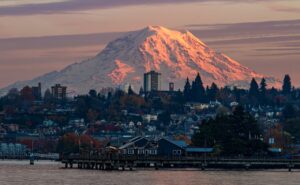The 10 Hottest States in the U.S., Ranked

Hot weather can be a nice change of pace from the gloom of winter, and is often welcomed in particularly cold and rainy parts of the country. Many people look forward to the warmth and sunshine all year, and even migrate to find it. Too much heat, though, can be a problem.
Unfortunately, if you were to describe this summer so far in one word, it would be hot. 2023 was already the hottest year in modern history, and 2024 is shaping up to be even hotter. The heat is inescapable, too, as ocean temperatures (SSTs) have also been at record highs for months, only exacerbating the issue. Multiple record-breaking heat waves have already impacted many cities around the world – especially the U.S – and they show no signs of letting up.
So, as summer cranks up the heat, we thought it would be helpful to break down the hottest states in the U.S. Whether you’re looking to escape the heat or become one with the sun, this list is for you.
How do we measure the hottest states?
For our purposes of determining the “hottest” states, this list will measure a state’s average summer temperature. This way, we can account for states that see very hot summers but also have milder winters, instead of exclusively favoring tropical locations that are warm year-round. We will also be including a state’s average annual temperature, but won’t use it for ranking purposes.
An average summer temperature combines a state’s average daily high and low temperatures from June-August. An average annual temperature combines a state’s annual average daily high and low temperatures and averages them into one number.
The heat index (a “feels like” temperature) is also essential to keep in mind. Heat indexes account for both air temperatures and relative humidity.
Note: It’s important to remember that our rankings account for the entire state, not just one city. You may think of a state as hot because a city in that state has a reputation for high temperatures (i.e. Palm Springs, Phoenix). However, other cities within that same state may experience much cooler weather, which brings the overall state average down.
What are the hottest states in the U.S.?
1. Texas
Average summer temperature: 82.3°F
Average annual temperature: 64.6°F
Record highest temperature: 120°F
Full of diverse cultures, cities, and cuisines, Texas is the hottest state in the U.S. Texas is so hot largely because of its flat landscape, most notably the Gulf Coast in the south, Chihuahuan Desert to the west, and Great Plains throughout. With few significant changes in elevation, along with just one natural lake, most of the state surpasses 100°F during the summer months. And when heat waves arrive, very little blocks their path.
Additionally, unlike other southern states, Texas sees both warm winters in its tropical southern coast and extremely hot summers in its western desert. El Paso is the hottest city in Texas, but cities like Corpus Christi along the Gulf of Mexico can see much higher heat indexes.
2023 was actually the hottest year in Texas history (3.5°F above average) and second-hottest summer. During a prolonged heat dome that year, multiple large cities broke heat records, including Dallas, Houston, and Austin, which saw weeks of 100°F temperatures. When paired with humidity, the heat index reached dangerous levels at times. If you’re interested in moving to the Lone Star State, be sure to prepare for hot weather in order to stay cool in extreme heat.
Texas homes for sale | Texas houses for rent | Texas apartments for rent
2. Louisiana
Average summer temperature: 81.9°F
Average annual temperature: 66.4°F
Record highest temperature: 114°F
Just east of Texas, Louisiana is the second-hottest state in the U.S. The state’s heat comes from its location on the Gulf of Mexico and near the equator, helping provide warm, humid air for most of the year. Heat domes, or prolonged pockets of high pressure, can lead to intense heat waves.
Importantly, the heat index plays a major role in Louisiana’s heat. For example, the northern regions of the state can easily reach 95-100°F, in cities like Ruston and Monroe. Areas along the coast rarely experience temperatures above 95°F. However, when accounting for humidity, the coast actually feels hotter much more frequently than inland.
Climate risks are also a big concern for most of the state, especially along the Gulf Coast. Strong storms can often bring flooding to cities like New Orleans and Baton Rouge, which sit at or below sea level.
Louisiana homes for sale | Louisiana houses for rent | Louisiana apartments for rent
3. Florida
Average summer temperature: 81.8°F
Average annual temperature: 70.1°F
Record highest temperature: 109°F
A state full of natural beauty, centuries of European history, and all the amenities you could want, Florida comes in as the third-hottest state in the U.S.
Florida has a humid subtropical climate and is by far the warmest state in the contiguous U.S. based on average annual temperatures. The tropical climate helps keep temperatures relatively warm year-round, but never extremely hot. Heat indexes, however, can reach well over 110°F. In fact, 2024 has already been a record year for Florida heat.
Florida is unique because its climate is especially influenced by Atlantic Ocean temperatures, which have been at record highs for months. A few ocean temperature readings south of Miami even topped 100°F in 2023. And as the ocean heats up, so does the air. Extreme weather, including hurricanes, also become more common.
Florida homes for sale | Florida houses for rent | Florida apartments for rent
4. Oklahoma
Average summer temperature: 80.3°F
Average annual temperature: 59.7°F
Record highest temperature: 120°F
Oklahoma sees big swings in temperatures from season to season, largely because of its location on the Great Plains – individual weather systems generally dictate the climate. In fact, if measured during any other season, Oklahoma wouldn’t make this list.
In general, Oklahoma’s winters are cool and mild, while summers are quite hot and humid. Summers are hot due to southerly winds bringing hot, dry air from Texas and the Gulf of Mexico, which flow uninterrupted over Oklahoma’s relatively flat landscape. Large temperature and humidity swings can produce extreme weather, too, especially tornadoes and thunderstorms. The western Panhandle is the coldest region in Oklahoma.
Oklahoma homes for sale | Oklahoma houses for rent | Oklahoma apartments for rent
5. Mississippi
Average summer temperature: 80.2°F
Average annual temperature: 63.6°F
Record highest temperature: 115°F
A deep south state known for its musical roots, Civil Rights history, and namesake Delta, Mississippi is the fifth-hottest state in the U.S. The state gets a lot of its heat from the Gulf of Mexico, which, when combined with very high humidity, can make summers exceptionally hot. Temperatures are lovely during the winter, though, which is a fair trade off for many residents.
Rainfall is fairly evenly distributed throughout the year, generally coming in strong bursts, but drought has been an issue recently. Jackson, Mississippi’s largest city, averages nearly 60 inches of rain per year.
If you’re considering moving to the Magnolia State, Mississippi is one of the cheapest states to buy a house in the U.S., which may be appealing. Buying a home in Tupelo, MS, for example, only costs $250,000. The state’s poverty rate is the highest in the nation, though.
Mississippi homes for sale | Mississippi houses for rent | Mississippi apartments for rent
6. Hawaii
Average summer temperature: 79.4°F
Average annual temperature: 76.4°F
Record highest temperature: 100°F
Hawaii is a truly tropical state, where the length of day and temperatures are generally the same throughout the year. Seasonal temperature variations are very small – summers are only 3°F warmer than the annual average, and the hottest temperature ever recorded is just 100°F. Thus, it’s no surprise that Hawaii is the warmest state based on average annual temperature. These conditions have helped Hawaii become a renowned vacation destination.
However, the state’s cost of living is the highest in the country. Housing is especially expensive. For example, if you’re planning on buying a home in Honolulu, Hawaii’s largest city, you’ll find house prices to be around $600,000.
Even though temperatures are relatively stable (except on the highest mountain peaks), rainfall varies widely depending on location. This is largely because of the trade winds, which bring consistent, moist air to the northeastern (windward) sides of the islands. Places like Hilo on the northeast coast of the big island, for example, see upwards of 130 inches of rain per year, while towns like Puako on the southwestern side may see just 10 inches. The absence of trade winds – and winter storms – can lead to drought.
Hawaii homes for sale | Hawaii houses for rent | Hawaii apartments for rent
7. Georgia
Average summer temperature: 79.4°F
Average annual temperature: 63.4°F
Record highest temperature: 112°F
Georgia comes in at number seven on our list of the hottest states in the U.S. Georgia is known for its beautifully-varied landscapes, from coastal plains around Savannah to the rolling hills in Atlanta. You’ll also find endless amenities, ranging from professional sports and massive aquariums, to historic museums and great restaurants.
Georgia’s climate is defined by the hot Gulf Mexico and cooling Appalachian Mountains, so the state sees all four seasons. Summers are hot and humid, while winters are mild and can be cold in the northeast. Winter freezes are rare, but summer can bring heat waves and thunderstorms. Storms along the Atlantic coast are not uncommon.
Georgia homes for sale | Georgia homes for rent | Georgia apartments for rent
8. South Carolina
Average summer temperature: 79.4°F
Average annual temperature: 62.4°F
Record highest temperature: 113°F
South Carolina is known for its southern hospitality, historic towns, pristine beaches, and warm, sunny weather. Homes are pretty affordable in many cities, too, like Columbia ($255,000) and Myrtle Beach ($317,500). Warm weather, affordable homes, and plenty of amenities is an appealing offer, and people are taking advantage of it. South Carolina grew faster than any other state in 2023.
South Carolina’s climate varies widely depending on where you live. The Blue Mountains in the northwest are much cooler than the warm, humid Lowcountry, for example. However, warm weather is generally common year-round, and can get hot during the summer. Plenty of rain falls across the state.
South Carolina homes for sale | South Carolina houses for rent | South Carolina apartments for rent
9. Alabama
Average summer temperature: 79.3°F
Average annual temperature: 63.1°F
Record highest temperature: 112°F
Alabama comes in at number nine on our list. Home to the largest space museum in the world, pivotal Civil Rights landmarks, renowned barbecue and seafood restaurants, and a distinctly southern feel, there’s a lot to love. Birmingham and Mobile are Alabama’s largest cities.
Similar to most southeastern states, Alabama’s climate is generally warm and humid. Summers are quite hot, especially when accounting for humidity. Additionally, the state’s proximity to the Gulf of Mexico and Appalachian Mountains influences weather patterns, which can often turn turbulent. Tornadoes and hurricanes are both major risks near the coast, while bursts of heavy rainfall are common year-round.
The hottest temperature recorded in Alabama was 112°F in Centreville, located in the flat upper coastal plain. Tuscaloosa is the state’s hottest city on average.
Alabama homes for sale | Alabama houses for rent | Alabama apartments for rent
10. Arizona
Average summer temperature: 79.3°F
Average annual temperature: 59.3°F
Record highest temperature: 128°F
A notoriously dry, hot state, Arizona rounds out our list of the hottest states in the U.S. Diverse natural beauty is one of Arizona’s defining features, with landmarks ranging from canyons and sandy desert, to tundra and flower-carpeted plains. Grand Canyon National Park, Coconino National Forest, Antelope Canyon, and Saguaro National Park are a few highlights.
Phoenix is the largest city in Arizona. Yuma is the hottest city in the state, as well as the sunniest city in the world.
Arizona makes the list primarily because of extremely hot summers in the Sonoran desert, where most of the state’s population lives. In fact, the northern half of the state is relatively mild during the summer, especially on the highest peaks of the Colorado Plateau. Flagstaff, for example, has an average July temperature of 81.3°F, compared to 106°F in Phoenix. The hot desert valleys help Arizona make the list over neighboring states like Nevada and New Mexico.
Arizona homes for sale | Arizona houses for rent | Arizona apartments for rent
Methodology
Data comes from the National Centers for Environmental Information (NCEI) and its parent administration, the National Oceanic and Atmospheric Administration (NOAA). Average summer temperatures are a three-month average based on data from June-August 1994-2024. Average annual temperatures are a twelve-month average based on data from 1901-2000. Record-high temperature data found here.
Note: Hawaii data was gathered by aggregating average temperatures from four cities across the state’s four major islands. NCEI does not have statewide data for Hawaii, Alaska, or U.S. territories.
The post The 10 Hottest States in the U.S., Ranked appeared first on Redfin | Real Estate Tips for Home Buying, Selling & More.







